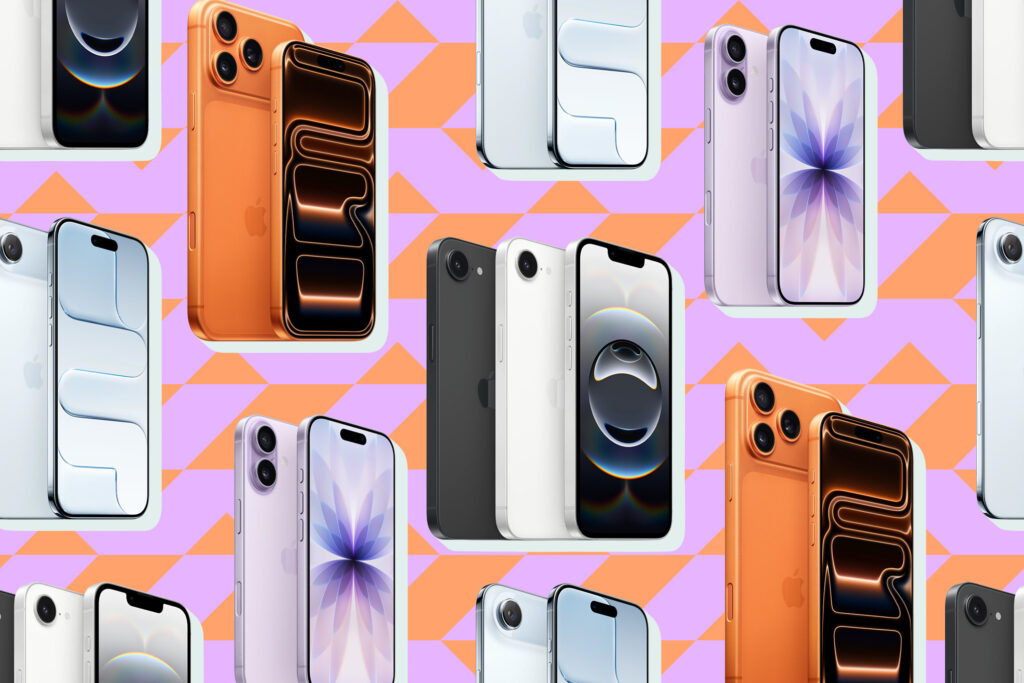
If you’ve been holding off on getting a new iPhone, now’s the perfect time to size up your options. Apple recently launched its 2025 iPhone lineup, which includes the iPhone 17, 17 Pro, 17 Pro Max, and a brand-new model, the ultra-thin iPhone Air. These new phones offer a number of new features over their predecessors, such as upgraded cameras, faster chips, better battery life, and even better screens — Apple Intelligence, however, is still a work in progress.
Alongside the new hardware, Apple also launched iOS 26 (yes, the numbering system has changed and we’re jumping from iOS 18), which includes a new Liquid Glass user interface, live translation, wallpapers in messages, and more. The software marks Apple’s biggest visual redesign since iOS 7, and despite some very polarizing reactions, we think it looks fine.
If your current iPhone is humming along, there’s no need to rush out and get a new one. But if you’re questioning whether it’s the year to replace your iPhone that’s a few generations old, then I think the answer is an easy yes. There are real gains to be had this time around, especially in the basic iPhone 17, which features a higher-refresh-rate display than last year’s model for smoother-looking animations, plus double the base storage to 256GB — all without raising the price, despite the current tariff situation.
The best iPhone for most people
Apple iPhone 17

Score: 8
| Pros | Cons |
|---|---|
|
|
Where to Buy:
Screen: 6.3-inch 2622 x 1206 OLED, 120Hz refresh rate / Processor: A19 / Cameras: 48-megapixel f/1.6 main with sensor-shift IS; 48-megapixel ultrawide; 18-megapixel selfie / Battery: Not advertised / Charging: 40W wired, 25W wireless MagSafe / Qi2 / Weather-resistance rating: IP68
The iPhone 17 marks a turning point for the standard model. After years with a lower-quality screen, the cheapest model finally got two major upgrades for 2025: an always-on display and a high-refresh-rate panel. These features make it feel meaningfully better than the iPhone 16 and prior models in everyday use, bringing it closer than ever to the Pro models. And at the same $799 starting price as the previous generation, this year’s update is a no-brainer.
While the iPhone 17’s 48-megapixel main camera is carried over from last year, the ultrawide camera has been changed from a 12-megapixel sensor to a 48-megapixel sensor, and it delivers sharper and more vibrant photos. The device features an 18-megapixel Center Stage selfie camera, which is also in the Air and 17 Pro. Your selfies may not look materially better, but the front camera’s square sensor elevates the user experience, making it possible to take horizontal selfies while holding the device vertically (no need to rotate the phone).

Apple also gives you double the storage — 256GB versus 128GB in the base iPhone 16 — and improved battery life. The standard 17 still lacks a proper telephoto camera, and the A19 chip is slower than the A19 Pro found in the Pro models. Still, it’s a big step up in almost every way, even if it looks basically the same as every iPhone from the past six years.
Read our iPhone 17 review.
The best high-end iPhone
iPhone 17 Pro

Score: 8
| Pros | Cons |
|---|---|
|
|
Where to Buy:
Screen: 6.3-inch 2622 x 1206 OLED, 120Hz refresh rate / Processor: A19 Pro / Cameras: 48-megapixel f/1.78 with sensor-shift IS; 48-megapixel 8x telephoto with OIS; 48-megapixel ultrawide; 18-megapixel selfie / Battery: Not advertised / Charging: 40W wired, 25W MagSafe / Qi2 / Weather-resistance rating: IP68
The iPhone 17 Pro introduces a bold redesign and a number of notable upgrades, including the lineup’s most advanced camera setup yet. It also features rounded edges, and similar to last year, it’s on equal footing with the 17 Pro Max in terms of performance; the biggest differences that the Pro Max offers a larger display, a larger battery, and up to 2TB of storage.
Whereas the iPhone 17 is for most people, the 17 Pro is more geared toward creators. The device has three 48-megapixel cameras, including a 48-megapixel telephoto, and it offers several pro features aimed at those who want to take the best possible photos and videos. Some of those features include Genlock support, which lets videographers sync up timecodes across multiple cameras, and support for ProRes RAW recording. It also sports the upgraded Center Stage selfie camera found in other 2025 iPhone models.

Despite the additions and improvements, there’s little here that makes the 17 Pro an absolute must-upgrade. However, it comes in an irresistible orange, which is apparently the new “it” color.
Read our iPhone 17 Pro review.
The iPhone with the best battery life
iPhone 17 Pro Max

Score: 8
| Pros | Cons |
|---|---|
|
|
Where to Buy:
Screen: 6.9-inch 2868 x 1320 OLED, 120Hz refresh rate / Processor: A19 Pro / Cameras: 48-megapixel f/1.78 with sensor-shift IS; 48-megapixel 8x telephoto with OIS; 48-megapixel ultrawide; 18-megapixel selfie / Battery: Not advertised / Charging: 40W wired, 25W MagSafe / Qi2 / Weather-resistance rating: IP68
The iPhone 17 Pro Max’s redesign isn’t just about looks. Apple hollowed out the device’s aluminum frame to fit in the biggest battery yet in an iPhone. Apple says the device offers up 39 hours of video playback, which is 12 more hours than last year’s iPhone 16 Plus, our previous battery champ. The device can easily push through a full day and then some, though your mileage will vary depending on how often you play mobile games, watch videos, and doomscroll on social media.

There are other benefits to going with the 17 Pro Max. It has the largest display among the latest iPhone lineup — 6.9 inches — and offers up to 2TB of storage, giving creators more room than ever for storing their media. If you want the most iPhone you can possibly get, including the longest battery life, then the 17 Pro Max is the way to go.
Read our iPhone 17 Pro Max review.
The best iPhone for people who hate bulky phones
iPhone Air

Score: 7
| Pros | Cons |
|---|---|
|
|
Where to Buy:
Screen: 6.5-inch 2736 x 1260 OLED, 120Hz refresh rate / Processor: A19 Pro / Cameras: 48-megapixel f/1.6 main with sensor-shift IS; 18-megapixel selfie / Battery: Not advertised / Charging: 30W wired, 20W MagSafe / Qi2 / Weather-resistance rating: IP68
The iPhone Air is Apple’s biggest redesign since the iPhone X was released in 2017. It’s shockingly thin and light, at 5.6mm and 165 grams, respectively. Thanks to its titanium frame and Ceramic Shield 2 display, it’s more durable than you might expect, too. The device feels deceptively small, despite having a 6.5-inch display. You really have to see and feel the phone yourself to get the appeal.
But the thinner design comes with a few substantial compromises compared to the other models available this year. One of the biggest is that the Air features a single 48-megapixel camera on the back. That’s not to say the device’s camera is bad. But it’s a far less versatile system than even the far more affordable iPhone 17, which has a dual-camera setup. The second compromise is on battery life, which is just okay. It’s not terrible, but it’s not great, either.

At $999, you’re paying a lot for middling battery life and camera performance. Those who primarily care about design, though, may be more forgiving about those shortcomings.
Read our full iPhone Air review.
The best inexpensive-ish iPhone
iPhone 16E

Score: 7
| Pros | Cons |
|---|---|
|
|
Where to Buy:
Screen: 6.1-inch Super Retina XDR / Processor: A18 Cameras: 48MP Fusion with 1x and 2x optical zoom, 12-megapixel selfie / Battery: Not advertised / Charging: 20-watt wired, 7.5W Qi, no MagSafe/ Weather-resistance rating: IP68
This recommendation comes with a heavy sigh. Yes, the 16E is the cheapest new iPhone Apple sells. Yes, it’s a good phone. It has a capable camera, reliable performance, full water resistance, wireless charging, and will be supported with software updates for years to come. But its $599 price tag starts to feel like too much when you consider what it’s missing.
There’s no MagSafe, which you can kind of add by way of a MagSafe case, but it’s a bummer not to have it built in when it has basically become a standard iPhone feature. There’s no ultrawide camera, no Dynamic Island housing timely information, no camera control button (not a huge loss, honestly), and no Ultra Wideband for precise object tracking. It does support Apple Intelligence, but that doesn’t feel like much of a consolation, given that it’s very much still a work-in-progress.
The 16E will most likely receive more years of software support than a previous-gen model like the iPhone 14 or 15. And sure, Apple Intelligence might turn into something useful someday. The 16E is a good choice if you want the path of least resistance to blue bubbles and FaceTime at your fingertips. But if you’d like MagSafe, a more advanced camera, and some of the other bells and whistles that got lost on the way to the 16E, then it’s not a bad idea to look at one of the older iPhones.
Read my full Apple iPhone 16E review.
What’s coming next
Apple’s latest iPhone lineup is available now, but there are already reports about what’s next. One report suggests Apple is readying a book-style foldable iPhone for 2026, which allegedly looks like two iPhone Air models put side by side. Apple is reportedly still working to flatten the crease that appears when the phone is unfolded, but has otherwise settled on a design. Looking ahead to 2027, a report claims Apple is planning a redesigned “all-screen” iPhone to celebrate the device’s 20th anniversary. These upcoming releases are allegedly part of Apple’s three-year plan — starting with the new iPhone Air — that’s aimed at refreshing its smartphone lineup.
Update, September 22nd: Updated to reflect current pricing / availability, and added the iPhone 17, 17 Pro, 17 Pro Max, and Air as new picks. Brandon Russell contributed to this article.




This is an interesting take on the new iPhones and their role in the AI era. It’s exciting to see how technology continues to evolve and integrate into our daily lives. Looking forward to seeing how these advancements impact user experience!
I completely agree! The integration of AI features is definitely a game-changer. It’ll be fascinating to see how these advancements enhance everyday tasks and user experiences in the coming years.
Absolutely! The AI capabilities can really enhance user experience, especially with personalized recommendations. I’m curious to see how these features will evolve in future updates as well!
I agree! It’s fascinating how AI can tailor recommendations to individual preferences, making the overall experience more intuitive. I’m also curious to see how these advancements might improve battery life and app performance in the new models.
Absolutely! It’s impressive how AI not only personalizes recommendations but also enhances overall user experience, making devices more intuitive. The integration of AI in new iPhones really seems to elevate functionality in everyday tasks.
Absolutely! AI’s ability to learn from user behavior makes these new iPhones even more intuitive. It’s fascinating how features like improved camera capabilities can also leverage AI for stunning photos, making it a game-changer for content creators.
Absolutely! AI really does enhance user experience significantly. Plus, with the integration of advanced camera features, these new iPhones are not just smarter but also better at capturing moments in stunning detail.
I completely agree! The integration of advanced AI not only improves user experience but also streamlines everyday tasks, making the iPhone even more efficient. It’s exciting to see how these innovations will shape our interactions with technology in the future.
Absolutely! It’s fascinating how AI can personalize features based on our usage patterns, making each device feel more tailored to individual needs. I’m excited to see how this will evolve in future models!